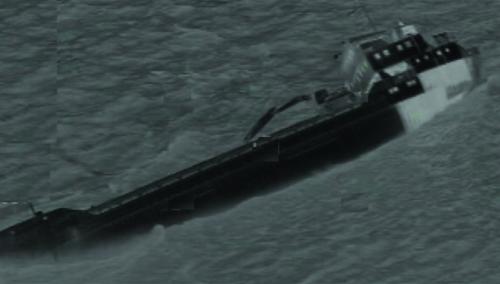202419: Dynamic separation of soil cargo contributes to sinking
As edited from the Norwegian Accident investigation report SJØFART 2023/01 (original report only available in Norwegian)
A small bulk carrier was carrying a load of soil which had been loaded, in bulk, into the single hold. The soil had been stored in unprotected heaps ashore and was loaded using an excavator. During loading, it was observed that some of the soil ‘flowed’ across the cargo hold when released by the excavator.
Once loading was finished, the cargo was evenly distributed in the cargo hold, although slightly higher in the middle of the heap. The crew readied the vessel for the voyage and closed the cargo hatches. Once underway, they encountered increasing swells and wind from starboard. Somewhat later, the vessel started listing to port, and the crew suspected that the cargo had shifted. This was confirmed visually when crew saw that moist soil was sloshing on top in the middle of the hold. This was evidence that either liquefaction or dynamic separation had occurred.
The Master decided to turn the vessel around and seek shelter. As this manoeuvre was being undertaken the vessel suddenly took a strong list to starboard and the crew soon realized that they were in danger due to a loss of stability. A distress call was sent and the crew evacuated the vessel by jumping into the sea wearing immersion suits. All five were
eventually picked up by a rescue helicopter. The vessel gradually lost buoyancy and sank as a result of water ingress into the cargo hold and other areas following the loss of stability caused by cargo liquefaction or dynamic separation.
The official investigation found it likely that there was moisture in part of the stockpiled soil that was loaded. The ship’s movements caused the cargo to undergo a transformation and initiated the sequence of listing events which culminated in the foundering of the vessel. As it happened, no samples were taken of the cargo, and the cargo was not tested for its transportable moisture limit (TML). The IMSBC Code does not list soil as a Category A cargo, so testing was not a requirement. Neither the shipper nor the vessel’s crew were familiar with the properties of the cargo.

As the report mentions, only special vessel design may help to reduce the potential consequences of cargo shifting when transporting a bulk cargo with an unknown TML. As it stands, there is probably inadequate knowledge in the industry of the requirements that apply to documenting the properties of soil to be carried as bulk cargoes.
Lessons learned
- While liquefaction or dynamic separation has been observed as a key safety issue when dealing with such cargoes as iron ore fines or nickel ore, soil has escaped this attention, probably due to the relatively low volumes transported by sea in bulk.
- This accident demonstrates that certain soils can liquefy or are subject to dynamic separation under certain conditions of moisture content and vessel movement.
- If, during loading, there is reason to suspect that the moisture content is in excess of the TML, stop loading the cargo, inform the owners and seek further advice from your P&I Club.
- If laboratory tests have not been conducted on the cargo, crew can carry out a complementary test on board, known as the ‘Can Test’ in order to determine, approximately, whether the cargo is at risk of flowing. Fo example, see the following publication:https://www.londonpandi.com/media/2142/reducing-the-risk-of-liquefaction-operational-guidance-for-vessels-that-carry-cargoes-which-may-liquefy.pdf
